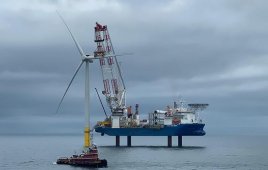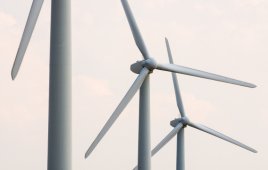
Paul Dvorak
Give Robert Bryce credit. The Senior Fellow at think-tank Manhattan Institute (manhattan-institute.org/html/ir_18.htm) knows how to write a convincing anti-wind column. Actually, it’s quite easy: Ignore anything remotely positive about the wind industry, don’t pose obvious questions that might reflect badly on your argument, and hope the equally un-inquisitive reader never gets to the end of the article. Should we expect to read equal treatment of wind’s competitors, the oil, gas, and atomic industries? Don’t count on it. Let’s first state our case and then look at his arguments.
Wind is a fledgling industry, in its model-T era so to speak, but developing quickly. It’s disruptive technology because it threatens to produce power at lower cost than conventional thermal generation methods. Opponents can clearly see that and so work to squash it.
The wind industry is now at a cross road of sorts with the expiration of the Production Tax Credit at year’s end. The credit rewards wind-energy producers with 2.2 cents/kWh. It rewards production, and it’s just enough to make wind farms profitable. The genuine concern is that if the PTC is not renewed, thousands will lose their jobs. That is true. Construction crews will be let go and factories, many European turbine manufacturers that invested millions to set up shop in this country, will close their doors. Supply chains will also dissolve. It takes a cold heart not to care about those companies and people.
Now let’s address the criticisms that the wind industry receives excess Federal support.
My first observation: How odd that the subsidies and tax credits received by the coal, gas, and atomic industries do not bother critics. A fair argument would be to eliminate all tax breaks. Critics do not make that one. They are also not bothered to ask why only the wind industry has limits to its tax credits.
The truth is that the Federal and state governments frequently give tax breaks to new companies to get them on their feet. The Atomic industry got its start during WWII with enormous government support, and rightly so. And when the war ended, the funding kept on coming to beat some of that sword into a plow share. Atomic energy was to be so cheap it would not have to be metered. Remember that one?
One argument is that if the same level of subsidies given to wind over the last few years were applied in proportion to thermal producers, the amount would reach $76 billion. Thankfully, that has not happened. But here’s a counter thought: If the atomic industry (just to pick on one competitor) has reduced its tax credits at a rate of just $0.005 less per kWh than it charged (Wikipedia says the industry produced about 806 TWh last year. Assume the figure an average.) it would have saved rate payers $78 billion over the last 20 years.
One panelist at an AWEA conference suggested six years would be a sufficient PTC extension. Even AWEA president Denise Bode acknowledges that tax credit need not be extended forever. This remarkable admission was left for the end of the critique. It’s remarkable because it’s difficult to image anyone in the coal, gas, or atomic industries suggesting a sunset date to their tax breaks.
The natural-gas industry is really the one to admire. It is so successful its product sells for $2.82/million BTUs. (Henry Hub spot prices, as of June 29, bloomberg.com/energy) For wind to compete at such a low cost today, the figure would have to nearly triple, to about $6.50/million BTUs. It could happen. For instance, with natural gas so cheap, why drill for more? A friend who works for a manufacturer of gas-drilling supplies tells of a recent order cancellation because of just such a slowdown. So expect natural gas prices to rise.
The nice thing about wind omitted from the critique is that even critics know the cost of the fuel to drive a wind turbine. They know what it is today, what it will be in six years, and in 40 years. It is and will be zero. Building the turbine to produce power at the cost of natural gas will happen. It’s just a matter of time.
The truth is that the nation needs wind’s competitors to produce the enormous base load required by an active and prosperous country, and they need wind power as a way to conserve and supplement fossil fuels.
–Paul Dvorak
Filed Under: Policy





For another perspective, see article and links at:
http://thegwpf.org/best-of-blogs/5953-roger-helmer-mep-more-misinformation-on-wind-energy.html
From the latest Turbomachinery International blog:
“Dresser-Rand has purchased all patents, trademarks and other intellectual property associated with compressed air energy storage (CAES) technology developed by Mikhail Nakhamkin, and is retaining Dr. Nakhamkin, owner Energy Storage and Power LLC (ES&P), as a consultant…”
General Electric has invested in another CAES technology, developed by Sustainx:
http://www.sustainx.com/
If this keeps up, Robert Bryce will have to find a new angle.
Mr. Fleming:
Thanks for your comments, history of CAES, and update.
Paul Dvorak
Mr. Dvorak — your assertion that the cost of the fuel to drive a wind turbine is a constant $0 ignores the basics of our power market. Obviously, the price of electricity generated from renewables is not predicated on the cost of the fuel. Additional, it is apparent from your piece that you do not understand the tax benefits extended to oil and gas or perhaps the facts are irrelevant to you. You claim Mr. Bryce ignores the positive about wind. Maybe so. But your piece is not very forthcoming either.
–Lisa Linowes
George, We have “storage” already for wind. It is called, not burning coal before it is needed. The energy from wind is used immediately and results in the reduction of the use of coal in the thermal plants. Discussing a “storage” for the wind energy is a distraction from the fact that wind reduces the consumption of coal. The storage is that big pile of coal left on the ground until later, delay its combustion. Yes we still need coal and big thermal plants to maintain base load, but we can reduce the consumption of coal. Someday with adequate encouragement, wind installations will be more broadly distributed with improved transmission capabilities and have much greater impact on the baseload.
Please clarify in detail what are the various subsidies favoring coal, oil, gas, nuclear and the source of those funds. We need a detailed list of the subsidies that are not included in the monthly utility bill and paid out of the rate payers’ pocket, rather those subsidies are paid from the tax payer’s pocket from federal and state taxation and without full knowledge. Is it just the tax payer or is it the rate payer covering the expenses for mountain top restoration, super fund repair of blown ash dams and toxic wastes filling river valleys in mining regions, oil spill cleanup, nuclear waste transportation and repository, health care for asthma and cancers, railroad construction, highway maintenance, etc. Everything gets paid for by you and me one way or the other, but I would guess that our monthly electric bills would jump dramatically if the true costs of energy production from thermal plants were included in the monthly electric bill, rather than hidden behind years of tax supported subsidies. Let’s disclose what all of the thermal energy subsidies are and call a spade a spade and then it would be OK to get rid of all of them.
Paul, I’m all for competing methods to expand the generation fleet in this country. I am also for zero subsidies for all forms of energy. Business tax credits allowing the producers to deduct the cost of production from their income as the cost of doing business are allowed and should always be allowed. The trouble with our country is that everyone thinks they are entitled to a handout. That makes no sense. Ethanol production, in my opinion,is one of the stupidest things in the world. Let’s take a food source that the entire western hemisphere (and most of the eastern, for that matter) uses and needs to survive and inflate the price of it by taking food off the market to make alcolhol because the Communist anti-capitalistic EPA won’t let us harvest our own RENEWABLE ORGANIC oil. Last time I checked, oil still comes from organic material.
I know I just ticked off all the corn producers in southern Minnesota and Iowa, but the fact of the matter is that EVERY subsidy is money taken from tax payers either in the repective states, or collectively from the entirety of all US tax payers and given to someone else. Nobody likes to hear this phrase, but it’s all a form of welfare.
There’s a fundamental difference between getting money from the government (that’s you and I who happen to be blessed with a job that pays enough to have taxes taken out) and being allowed to deduct your legitimate business expenses from your gross receipts to then calculate your business income taxes. God Bless you business owners creating wealth and jobs. Without you, there is no USA.
Free market comptetion in its purest form will drive the costs down for all sources of energy. That means nobody gets sweetheart subsidy deals. Give every energy producer the same tax deductions and let the consumer decide. We vote every single day for the products and services we want to succeed with our dollars. At the end of the day, those that get enough dollars to make a profit will survive.
Get the EPA out of the legislation business and stop trying to tell me how I have to live. That is Communism. Nobody is for dirty air or diry water. With the 24 hour news cycle we live in today, any business that is stupid enough to try to be environmentally irresponsible will be ratted out and forced to rectify any situation. Public outcry would be so great they would be forced to shut down if they didn’t. We don’t need the intrusive, destructive, anti-progress EPA invading our privacy and stealing our rights as American citizens.
The risk takers of the last century succeeded or failed on their own. That’s the beauty of this country. Keep the government out of business and business will succeed or fail based on the market. That’s the way it has always worked, and it’s how it will continue to work. The role of government is not to waste taxpayer money propping up business models that are destined to fail before they even bring a product to market. If private investors believe in a model, let them risk their own capital and receive the reward if it succeeds.
Paul Dvorak lables this ‘an honest response’. I would question its honesty.
Firstly, wind is hardly ‘a fledgling industry’. Wind turbine generators have been around for over 100 years and have been in widespread commercial use for over 40 years.
As for ‘threatening to produce power at lower cost than conventional thermal generation methods’, well that ‘threat’ has been around for decades, it seems in no danger of imminent delivery.
In the real world, whenever tax credits and production subsidies are reduced or stopped wind installation stops and its subsidised production facilities are closed. Report after report in Europe shows that wind power jobs are hugely subsidised and merely displace employment in more productive sectors.
In the UK we are heartily sick of hearing RenewableUK, the wind industry trade body, claiming that wind is “competitive with gas” and a “proven technology” then screaming blue murder when there is the slightest threat to their huge production subsidies.
Mr Bryce is only one of very many critics who think that wind is a waste of resources, damages communities and is totally ineffective in de-carbonising the economies of industrialised nations.
All good points, but I would not be so mild with Robert Bryce. For a stronger response to his propaganda, including the question of subsidies, see Walter Borden’s comment on the article at
ttp://dotearth.blogs.nytimes.com/2012/05/23/a-closer-look-at-watts-and-joules-power-and-energy/
Bryce and other critics of wind power make the credible objection that wind power is variable and unpredictable, therefore it requires fossil fuel backup power. They claim that this makes wind power worthless.
The problem with this objection, which is in any case not completely valid, is that it would disappear if there were a way to store wind energy on a large scale.
I believe that the best way to do that is with CAES. The Norton Energy Storage project is going forward on that reasoning, but we need many more of these installations to get the most out of wind and solar power. For another example:
http://www.generalcompression.com/index.php/who
But critics such as Bryce never have the integrity to seriously examine the possibility of renewable energy storage. They are not interested in solving the energy problem. They are interested only in helping the fossil fuel industry perpetuate itself. I can think of only one motivation for their efforts.
State allowed not mandated, beg pardon.
I do give credit to Robert Bryce, to him I and my family are not “Collateral Damage”.
State Mandated 1000’Safety Setback from a non Participating Home Foundations, taking of your property for those safety setback’s, 50dba noise at night. The Industry only has itself to blame for people like me.